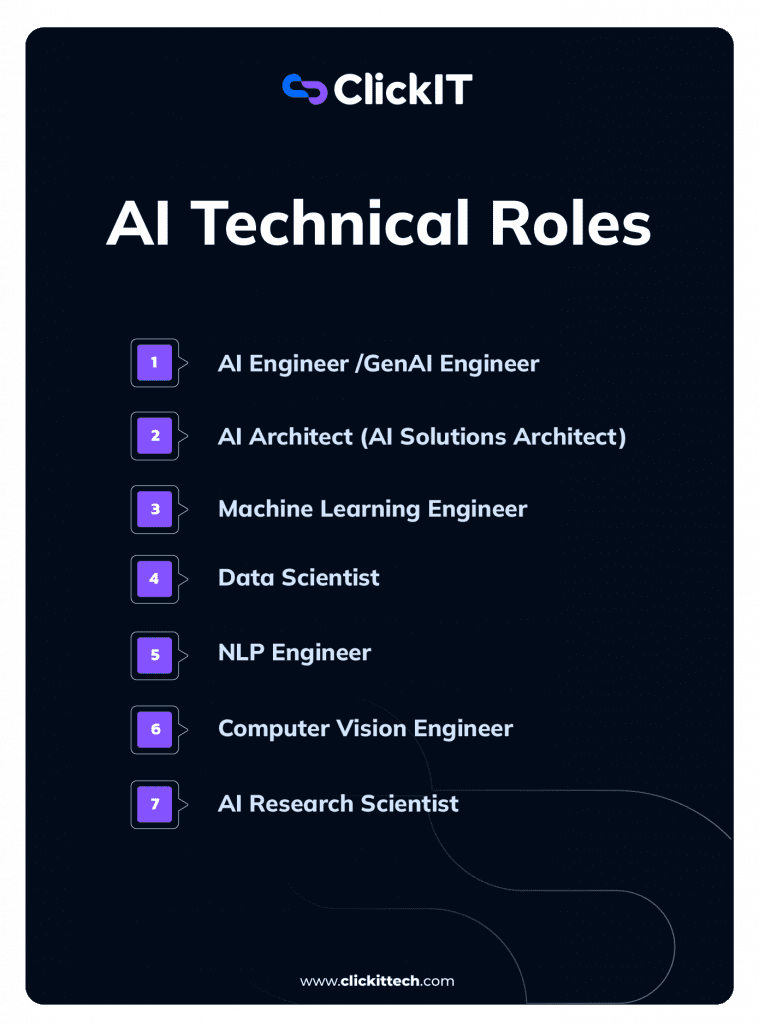Building a successful AI product requires more than smart algorithms; it requires the right people in the right roles. In this blog, I’ll provide a clear breakdown of the most important AI roles, including both technical and non-technical positions, and the key responsibilities, ranging from Data Engineers and ML Engineers to AI Product Managers and Prompt Engineers.
Whether you’re hiring an AI team or job hunting, this guide gives you a complete overview of today’s AI job roles.
In 2026, AI roles are no longer experimental or optional. Companies are moving from isolated AI features to complete AI-powered systems, including copilots, autonomous agents, and data-driven decision engines. This shift has forced organizations to redefine traditional roles and create entirely new ones focused on reliability, governance, and scale.
Unlike earlier AI waves, modern teams are structured around ownership: who designs intelligence, who deploys it safely, who maintains it in production, and who ensures business value. That’s why understanding AI roles is now a strategic decision, not just a hiring one.
- What are The Essential Technical AI Job Roles and Responsibilities in an AI Team?
- What Are the Key Non-Technical AI Roles in an AI Team
- Which AI Roles Does Your Company Actually Need?
- FAQs about AI Roles
What are The Essential Technical AI Job Roles and Responsibilities in an AI Team?
According to Innobu, 67% of mature AI organizations are creating new AI roles, and 87% have dedicated AI teams, so let’s take a look at the technical AI job roles and their skills.

What does an AI Engineer /GenAI Engineer do in 2026?
In 2026, AI Engineers build end-to-end AI-powered features using foundation models, APIs, and agent frameworks. Their work includes prompt engineering, retrieval-augmented generation (RAG), tool integration, and orchestration of multi-step AI workflows.
AI Engineers focus on making models useful inside products, connecting user intent, data sources, and business logic, rather than training models from scratch.
Implement AI solutions into applications, write the code to integrate AI models into software products, and develop new features powered by AI. They also fine-tune, optimize, and adapt models for production use, manage vectorized databases, ensuring that AI solutions are scalable, efficient, and user-ready.
This role handles everything post-training: from modifying weights and implementing inference strategies to connecting models with real-time tools and orchestrating AI agents.
For example, if a data scientist develops a recommendation algorithm, the AI developer ensures it’s correctly embedded into a web or mobile app and works for end-users.
Responsibilities and Skills
- Deep Learning Expertise: Strong understanding of neural network architectures and how to optimize them.
- Software Engineering: Good software design and debugging skills to integrate AI models into larger systems.
- Prompt Engineering: Develop one-shot, few-shot, and instruction-based prompting strategies to improve LLM response quality and reliability across tasks.
- Model Integration & Sampling: Embed AI models into software applications and implement efficient inference strategies like temperature tuning, top-k/top-p sampling, and response streaming.
- Fine-Tuning & Evaluation: Adapt base models (e.g., LLaMA, Mistral, GPT-J) for domain-specific use cases, using custom datasets and evaluation pipelines.
- Problem-Solving: Troubleshoot model performance issues and fine-tune algorithms for better accuracy and efficiency.
- Collaboration: Working closely with data scientists and DevOps teams, clear communication and teamwork are key to my role.
Technologies Used:
- Python, Java, C++
- TensorFlow, PyTorch
- Git, Docker, Kubernetes
- VS Code, Jupyter Notebook
- RAG, LangChain, LlamaIndex, FAISS, Pinecone, Weaviate
What does an AI Architect (AI Solutions Architect) do in 2026?
Designs the big-picture architecture of AI systems. An AI architect plans and structures how AI models and systems will fit into the broader technology stack.
They make high-level decisions about which technologies to use (such as cloud platforms and frameworks) and how components should interact.
They define the technical blueprint for how AI fits into the broader software ecosystem, selecting the right tools, setting infrastructure standards, and ensuring enterprise-grade scalability and governance.
Think of the AI architect as the “systems designer” who charts the roadmap that AI developers and engineers follow.
Responsibilities and Skills
- End-to-End AI System Design: Architect the full lifecycle of AI pipelines, including data ingestion (batch & real-time), model training/evaluation, and production deployment with feedback loops.
- Tech Stack Strategy: Choose the right tools, frameworks, and platforms for each part of the AI workflow, from data to deployment.
- Model Serving Architecture: Design scalable model-serving layers using Triton Inference Server, ONNX Runtime, or custom endpoints.
- RAG & Agent Architecture: For GenAI use cases, design modular retrieval-augmented systems using vector DBs and tool usage agents.
- Security & Compliance Awareness: Ensure that AI systems comply with industry standards, security protocols, and data regulations.
- Cross-Functional Leadership: Align product, engineering, and business teams around a unified technical vision.
- Documentation & Communication: Create technical diagrams, architecture specs, and roadmaps that guide teams and ensure clarity.
- Business Alignment: Translate business goals into architecture plans and ensure that our AI systems deliver measurable value.
Technologies Used:
- AWS, Azure, Google Cloud
- Lucidchart, Draw.io
- Terraform, CloudFormation
- Kafka, API Gateway
- Pinecone, Weaviate, LangChain
- FastAPI
- Kubernetes, ECS
What is the Difference between an AI developer and an AI Architect?
An AI Developer is primarily a builder, responsible for writing code, developing machine learning models, and turning data into working AI applications.
An AI Architect is the planner and designer of the overall AI system; they craft the high-level architecture, integrate various AI components, and ensure the solution aligns with the business goal.
So, the AI developer focuses on implementing AI solutions, while the AI architect focuses on strategizing and designing how those solutions fit into the bigger picture.

What does a Machine Learning Engineer do in 2026?
A Machine Learning Engineer in 2026 is responsible for taking trained models and turning them into scalable, reliable production systems. This includes model deployment, performance monitoring, retraining pipelines, and integration with real-world applications such as APIs, products, or AI agents.
Unlike earlier ML roles focused mainly on training accuracy, modern ML engineers prioritize latency, cost control, observability, and failure handling—especially in real-time and agent-based systems.
Also, monitor model performance and update models as needed.
Responsibilities and Skills
- Machine Learning Algorithms: Deep knowledge of regression, classification, clustering, and optimization techniques.
- Software Engineering: Apply clean code practices, CI/CD pipelines, and version control (Git) to ML codebases.
- Model Deployment: Familiar with wrapping models in APIs, containerizing them, and scaling them in production environments.
- Training Infrastructure: Build automated training workflows for retraining and versioning.
- Data Pipeline Management: Work with large datasets and build pipelines for training and inference.
Performance Optimization: Fine-tune model latency, memory usage, and throughput for real-time and batch environments. - Collaboration: Work closely with data scientists, MLOps engineers, and backend teams to drive effective solutions.
Technologies Used:
- TensorFlow, PyTorch, Scikit-learn
- Docker, Kubernetes,
- MLflow, Kubeflow, Airflow
- AWS SageMaker, Vertex AI, Azure ML Studio
- Prometheus, Grafana, Evidently, WhyLabs
What is the role of a Data Scientist in an AI team in 2026?
In 2026, Data Scientists are less focused on static dashboards and more involved in experimentation, feature engineering for AI models, and validating assumptions used by machine learning and generative systems.
They act as the bridge between raw data and intelligent behavior, helping teams understand what data is trustworthy, biased, or incomplete before it powers AI-driven decisions.
A data scientist utilizes statistics and ML to address business challenges, frequently creating visualizations or reports to communicate their findings effectively. They typically experiment with algorithms and refine models, but may not always take them to production.
Unlike ML Engineers, Data Scientists focus more on model exploration, feature experimentation, and business understanding, often owning the full EDA-to-model development pipeline but relying on engineering teams for deployment.
Responsibilities and Skills
- Exploratory Data Analysis (EDA): Profile, clean, and transform raw data to identify trends, anomalies, and business-relevant signals.
- Statistical Analysis: A firm grasp of statistics and linear algebra to effectively interpret data patterns.
- Predictive Modeling & Feature Engineering: Train and tune models focusing on feature creation and model interpretability.
- Programming Proficiency: Write efficient code (in Python, R, etc.) to manipulate data and implement models.
- Critical Thinking: Excel at framing the right questions and solving problems based on data insights.
- Data Storytelling: Use data visualization and communication skills to explain findings to stakeholders in clear, compelling ways.
Technologies Used
- Python, R, SQL
- Scikit-learn, XGBoost, LightGBM,
- Tableau, Power BI, Looker
- Pandas, NumPy, Jupyter Notebooks
What is the Difference between a Data Scientist and an ML Engineer?
A Data Scientist explores and analyzes data to uncover insights and build prototype models that help guide business decisions.
They utilize tools such as Python, SQL, and Jupyter to clean data, run experiments, and present their findings.
On the other hand, a Machine Learning Engineer takes those models and turns them into reliable, production-ready systems.
Their job is to deploy, scale, and monitor models using engineering tools like TensorFlow, Docker, and cloud platforms.
In short, the Data Scientist asks, “What can we learn from this data?”, while the ML Engineer ensures that learning is built into a scalable product.
Both roles are essential in the AI development lifecycle; one designs the intelligence, the other operationalizes it.

What is the role of an NLP Engineer in an AI team in 2026?
Specializes in AI that understands or generates human language. NLP engineers develop language models and algorithms for tasks like speech recognition, text analysis, translation, or chatbots.
They fine-tune models (such as GPT-style large language models) for language-based tasks and work on improving aspects like understanding context or sentiment in text. With the surge in voice assistants and chatbots, NLP engineers ensure these systems can converse naturally and accurately.
Responsibilities and Skills
- Text Preprocessing & Feature Extraction: Clean, tokenize, and normalize language data using tools like spaCy, NLTK, or custom pipelines, ensuring model-ready input.
- Transformer-Based Model Fine-Tuning: Customize pre-trained models on domain-specific corpora for tasks like intent classification or summarization.
- Linguistic Knowledge: Understanding of grammar, syntax, and semantics to help AI models better understand language.
- Attention to Detail: Small nuances in language matter; meticulous when preprocessing data and tuning models for quality outputs.
- Creative Problem-Solving: Crafting effective solutions (like dialogue flows or prompt phrasing) requires creativity and iterative experimentation.
- Continuous Learning: The NLP field evolves rapidly, so it is essential to continually learn about new models and techniques to keep language systems state-of-the-art.
Technologies Used:
- spaCy, NLTK, TextBlob
- Hugging Face Transformers, BERT, GPT
- OpenAI API, Dialogflow, Rasa
- Pinecone, FAISS (for semantic search)
What is the role of a Computer Vision Engineer in 2026?
Focuses on AI for visual data (images and videos). These engineers develop algorithms that enable machines to interpret and analyze visual inputs.
For instance, a computer vision engineer might work on object detection in images, facial recognition systems, or autonomous vehicle vision. They often use deep learning (CNNs) to have computers recognize patterns in visuals, from medical imaging diagnostics to augmented reality features.
Responsibilities and Skills
- Develop and fine-tune deep learning models for object detection, classification, segmentation, or pose estimation.
- Design image preprocessing and augmentation pipelines to enhance generalization across various lighting conditions, angles, and motion blur.
- Optimize inference performance for edge devices, ensuring low-latency results in real-world settings.
- Math & Image Processing: A strong foundation in linear algebra and calculus
- Pattern Recognition: Recognizing patterns and anomalies in visual data
- Optimization Skills: Fine-tune models to handle lighting changes, angles, or noise in images, ensuring robust performance in real-world conditions.
- Detail Orientation: Working with images requires keen attention to detail to verify outputs and ensure the AI misses nothing important.
Technologies Used:
- OpenCV, ImageAI
- TensorFlow, PyTorch
- YOLO, ResNet, EfficientNet, Vision Transformers, SAM
- CUDA, NVIDIA Jetson, GPUs
What does an AI Research Scientist do in 2026?
The innovator pushing the boundaries of AI. A research scientist in AI conducts cutting-edge research to develop new models or algorithms.
They often have advanced academic training and spend time prototyping ideas, publishing papers, and experimenting with novel approaches beyond current commercial uses.
Their work ensures the team stays at the forefront of AI advances. This role usually requires more academic background (often a PhD) and focuses on innovation, whereas roles like ML engineer focus on implementation.
Responsibilities and Skills
- Design and conduct research experiments to evaluate new model architectures, training objectives, and optimization techniques.
- Prototype experimental models using public or synthetic datasets.
- Theoretical Foundations: Deep understanding of ML theory, linear algebra, calculus, and probability.
- Research Methodology: Design experiments, run benchmarks, and validate hypotheses through rigorous testing.
- Academic Writing: Publish technical papers and contribute to conferences like NeurIPS, ICML, or ACL.
- Prototyping: Build experimental models to test new concepts and measure their performance.
- Collaboration with Engineering Teams: Work closely with developers to transition research into practical, applied solutions.
Technologies Used:
- PyTorch, JAX, TensorFlow
- MATLAB, NumPy, SciPy
- HPC clusters, TPUs, Colab Pro+
- Papers with Code, ArXiv, Weights & Biases, GitHub
AI Infrastructure & Platform Engineer (NEW ROLE)
AI Infrastructure and Platform Engineers design and maintain the systems that allow AI models and agents to run reliably at scale. This includes cloud infrastructure, GPUs, vector databases, orchestration frameworks, and monitoring tools.
In 2026, this role will have become critical as companies move toward multi-model architectures, autonomous agents, and real-time AI workloads. Without a strong AI infrastructure, even the best models fail in production due to cost overruns, downtime, or security risks.
What Are the Key Non-Technical AI Roles in a Team?
Not everyone on an AI team is writing code or building models. Non-technical AI roles are crucial for aligning AI projects with business goals, user needs, and ethical standards. Two key roles are:
AI Product Manager
This AI role connects the AI team’s work with business objectives. An AI Product Manager defines the strategy and vision for AI-powered products and features.
They translate business goals into AI project requirements, prioritize features, and coordinate between technical teams and stakeholders.
Responsibilities and Skills
- Translate high-level business objectives into actionable AI feature specs, working with ML teams to define model goals, evaluation metrics, and deployment milestones.
- Product Lifecycle Management: Oversee the entire process from concept to launch, skilled in planning, iteration, and agile methodologies.
- AI Literacy: Solid understanding of AI concepts and terminology
- Strategic Thinking: Align AI product features with business goals and market needs.
- Communication & Leadership: Strong interpersonal skills to help with engineers, executives, and other stakeholders around a shared product vision.
Tools Used:
- Jira, Trello, Productboard
- Miro, Figma (for user journeys)
- Google Analytics, Amplitude
- Familiarity with ML tools for effective collaboration (e.g., SageMaker, TensorBoard)
Ethics & Responsible AI Specialist (AI Ethicist)
AI systems can pose serious questions about fairness, bias, and compliance. The Responsible AI Specialist’s job is to ensure the AI products are developed and used ethically.
They develop guidelines and best practices for the responsible use of AI, and they review models for issues such as biased outcomes or privacy concerns. An AI ethicist helps the team answer questions like, “Should we do this, and how do we do it right?”
Responsibilities and Skills
- Develop and enforce Responsible AI frameworks that align with global standards, ensuring ethical and legal compliance throughout the ML lifecycle.
- Conduct bias and fairness audits, working with data scientists and engineers to identify sources of model drift, disparate impact, or privacy risks in datasets and outputs.
- Ethical & Legal Knowledge: Deep knowledge of AI ethics, relevant laws, and regulations, ensuring our AI follows all guidelines and societal norms.
- Fairness & Accountability Expertise: Skilled in concepts like fairness, transparency, and accountability in AI.
- Advocacy & Communication: Effectively communicate ethical concerns and rationales to both technical teams and leadership
- Cross-Functional Collaboration: Work closely with engineers, product managers, and legal teams.
Tool Used:
- AI Fairness 360, What-If Tool
- SHAP, LIME (model explainability)
- Compliance tools (e.g., OneTrust, BigID)
- Ethical guidelines from OECD, IEEE, EU AI Act
Both of these roles are about alignment and oversight: the product manager aligns AI with business strategy, and the ethics specialist aligns AI with societal norms and regulations.
Which AI Roles Does Your Company Actually Need?
Not every company needs a full AI team. In 2026, the right AI roles depend on maturity and goals:
Early-Stage Companies & MVPs
- AI Engineer
- Data Scientist
At this stage, speed matters more than optimization. Early teams need roles that can rapidly prototype AI features, validate ideas, and connect existing models or APIs into real products. AI Engineers and Data Scientists help teams experiment, learn from users, and avoid over-investing in infrastructure too early.
Hiring too many specialized roles at this phase often slows progress and increases costs without improving outcomes.
Scaling Products & Growing AI Usage
- Machine Learning Engineer
- MLOps Engineer
- Data Engineer
Once AI features are in production and usage grows, reliability, cost control, and performance become critical.
Machine Learning Engineers ensure models scale efficiently, while MLOps Engineers manage monitoring, retraining, and deployment pipelines. Data Engineers provide the stable data foundations required for consistent AI behavior.
This is the phase where many AI initiatives fail, not due to model quality, but because systems cannot scale sustainably.
Enterprise & Regulated Environments
- AI Infrastructure & Platform Engineer
- MLOps Engineer
- AI Product Manager
In enterprise settings, AI systems must meet strict requirements around security, compliance, observability, and governance.
AI Infrastructure Engineers design resilient platforms that support multi-model strategies, AI agents, and high-availability workloads. AI Product Managers ensure AI investments align with business value, risk tolerance, and user trust.
At this stage, AI success depends more on architecture and governance than experimentation speed.
FAQs about AI Roles
Machine Learning Engineers and Data Scientists remain the most in-demand. Around 75–80% of companies are hiring for these roles. Prompt Engineers are also rising quickly due to the boom in generative AI.
Other growing roles include AI Product Managers and AI Ethics Specialists, especially in regulated industries like healthcare and finance.
Roles like AI Research Scientist or AI Ethicist often require a master’s or PhD, especially when working on theoretical models or policy. In contrast, roles like ML Engineer, AI Developer, and Prompt Engineer focus more on practical experience, coding skills, and project work.
At startups, roles are broader; one person might handle everything from data cleaning to model deployment. At large companies, roles are more specialized, with dedicated teams for data, ML, infrastructure, and ethics. Startups prioritize speed and flexibility; big companies focus on scale and depth.






